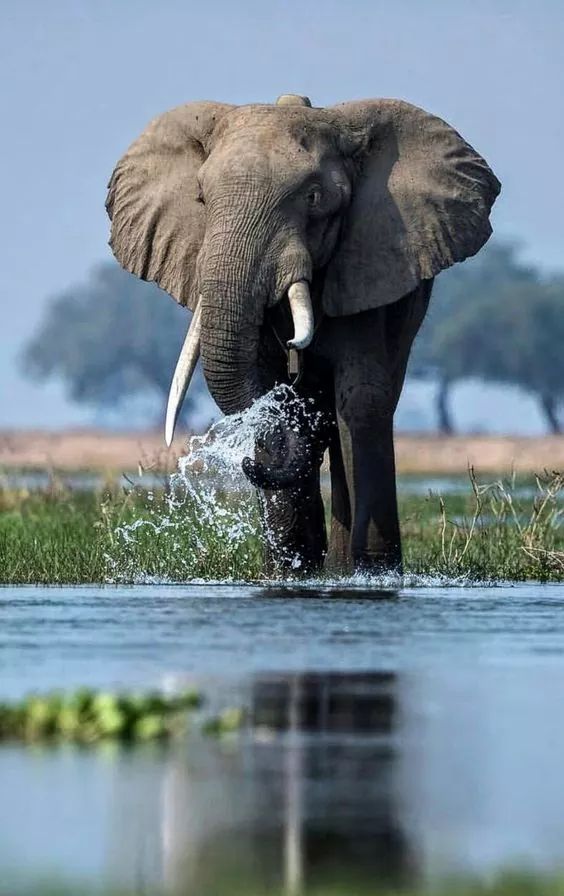
African Elephants spend way more time eating, than anything else. These huge animals eat vegetation about 18 hours in every 24 hours! So well over half their day is spent eating as they require vast amounts of vegetation to survive. Although they seem great at eating, their digestive system is not great — the food that goes in comes out the other end looking almost the same.
The ‘epidermis’ is the top layer of skin — the surface and an elephants epidermis on its ears, are 10 times thinner than the rest of the epidermis of their body. They need this design because it brings the blood vessels closer to the surface, thereby cooling the blood, which is circulated around the body — cooling the animal down.
An adult African elephant usually drinks about 200 litres of water (53 U.S Gallons) of water in one go.
When you see an African elephant cow walking along with a young calf near her and a slightly (not much) older calf joining them, it is likely she has adopted the calf as her own. Lactating cows will allow other calves to nurse from them and these calves return to their mother, so it is not a big deal for her to accept another calf and raise it as her own.
Other mammals have oil glands and they keep their skin soft and pliable. African Elephants do not have these glands. So, they use another way which locks in the moisture in so that their skin does not dry out in the African sun. They also roll in mud to make sure their skin will not crack.
A cow (African elephant) can remain fertile until their death — that is sometimes why you find old elephant cows with a young calf at foot.
- This old girl has not stopped breeding. She is closely followed by her older calf (if all goes well, they remain close to their mother for 10 years and still suckle from her), and a newborn.
The matriarch (female leader) of an African elephant herd is crucial to the development of any calf. She teaches calves in many important survival skills. By making good choices about when and where to travel will lead them to food, water and also avoiding danger.
African Elephants mature sexually between 9-12 years. Female offspring are allowed to stay on in the closely knit maternal herd while the males have to leave. Initially, they are encouraged to leave but if they linger on, are forcefully evicted by the family!
These males will then join other mature males in a loose association. Within this boys group, there exists a hierarchy based on age. Older males dominate the resources as well as get most mating opportunities.
The sketch below is of a young male being pushed about by two older males (his drinking buddies) at the watering hole to remind him of his low ranking. Possibly something similar to harassment of form ones in high school(monolisation).
Sex organ of a mature male elephant weighs up to 27kgs.
If you see an African elephant eating sand, do not think it is starving. This is perfectly natural behaviour as some places have a high mineral content and they are digging and eating sand for important minerals they need in their diet.
Old elephants are often found near water — as they will separate from the herd to hang out there. The vegetation growing in, or on the water’s edge, is softer and by that stage, their teeth are too worn to eat and digest what elephants usually eat. If they cannot get to those softer and nutritious plants — they slowly starve to death.
African Elephant calves are very important to a herd– so, please be careful never to frighten a baby, or distress it, as one little distress call from it, will not only bring the mother, but the entire herd responds to defend the calf.
Most continents lost the megafauna (large animals, or animals we can see with the naked eye) and the first to lose theirs was Australia. Out of all those continents, Africa has held on to theirs and that is due to our ancestors as they lived in harmony with the animals for millions of years. Only in modern times are we destroying them at an alarming rate. Stop poaching
African Elephants have large stomachs and can keep their food in their body for a long time. It takes 24 hours for food to pass through our digestive system. An elephant — two and a half days!
Bull African elephants only fight when they come into ‘musth’ — that is the elephant’s breeding time — only the male. His ‘musth’ can be from a few weeks to 3 months a year. During this time he has a lot more testosterone (a male sexual hormone), so he is more aggressive and this is the period where fights can occur — breeding rights. The males fight is a test of strength, and they only fight over the right to breed with the cows (female elephants).
Bulls usually live in herds — it is not just the females, and when musth is reached, the bull separates and travels to find a female herd. When his musth is over, he returns to his buddies.
- This is an important piece for every budding conservationist out there, and anyone, really, that needs to know the importance of these large herbivores in our ecosystem, and why too few of them, or none, will cause a huge part of the ecosystem to crash. So, please read and learn of their importance to our world from this interesting article 😉
African Elephants are Keystone Species
Every single species plays an important role in maintaining an ecosystem but some species have larger effect on their environment. Such species which displays critical ecological role in the ecosystem that other species cannot do are known as ‘Keystone Species’. The term ‘Keystone species’ was first used by Robert Paine in 1966 after extensive studies in examining food webs in an intertidal ecosystem.
Although there are many Keystone species in our ecosystems, African Elephants are very important ‘Keystone species’ in the wild. They maintain nature’s cycles without which some ecosystems would cease to exist. Their major role is maintenance and protection of biodiversity around their habitats. Some of there critical roles are:
- As ecosystem engineers, they make pathways in dense forests which makes it possible for other animals to pass through.
- Some trees in the forest like Acacia are known to cover spaces in a canopy which wouldn’t allow sunlight to penetrate to the lower plants. African Elephants use their energy during their massive feeding process to pull down some of those trees, thereby making openings for sunlight to reach other plants.
- They use their tusk to dig for water during dry season, which other organisms also benefit from, once the African elephants have left.
- The fallen logs and remains of trees after feeding becomes habitat for lizards and insects. It has been reported that wherever elephants are found, lizards are always found in many such places.
- Since African elephants eat a lot, they always have much dung (which is rich in nutrient) around their habitats which serves as habitat for fungi, beetle larvae, crickets and spiders among others as they feed on it.
- The dung from elephants also serves as fertilizer for plants since it has some vital elements for their growth.
- The footprints from the heavy legs of elephants during rainy seasons create small wells which collects water during rains where many organisms including birds get water to drink.
- Humans are hyperkeystone species since we engage in many complex interactions that affects other Keystone species in different habitats.
The flapping Ears of an African Elephant
Although African elephants flapping their ears could be a sign of excitement when one individual meets another, the main reason, however, it is an adaptation for cooling their body temperature. As they constantly generate energy through their daily activities, their body heats up, and most big animals, including elephants, find difficulty in lowering their temperature and keeping it there, so they have adapted.
As it happens normally, when the body temperature exceeds that of their environment, they need to release the heat through a cooling process. The big ears of elephants are covered with a thinner skin than that found on their body, therefore, the blood vessels are closer to the surface.
As more blood is supplied to the ears, it aids their flapping. With continuous flapping of the ears against the wind, the blood gets cool and therefore, reduces the body temperature.
This is another reason why the African forest and the African bush/ savanna elephant are two different species — their front toes.
The smaller African forest elephant has 5 toes on its front feet, and the bush/savanna elephant has 4 toes on its front feet.
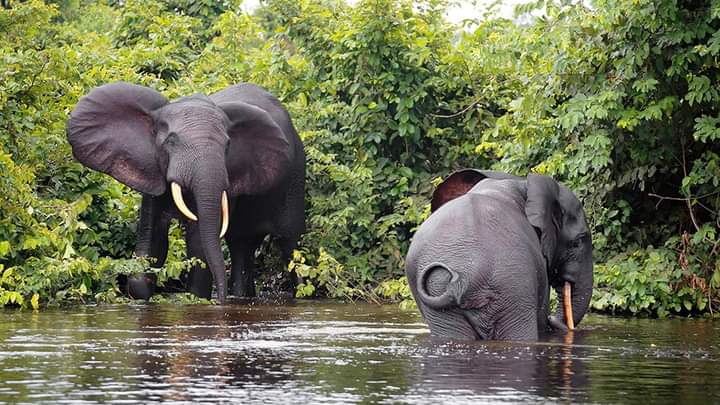
The African savanna/bush elephant cannot breed with the African forest elephant — they are different species.
Do you know you can tell the age of an elephant by looking at its footprints?
A young elephant leaves a more defined footprint than an older elephant, that usually has smoother ridges and well-worn heels.
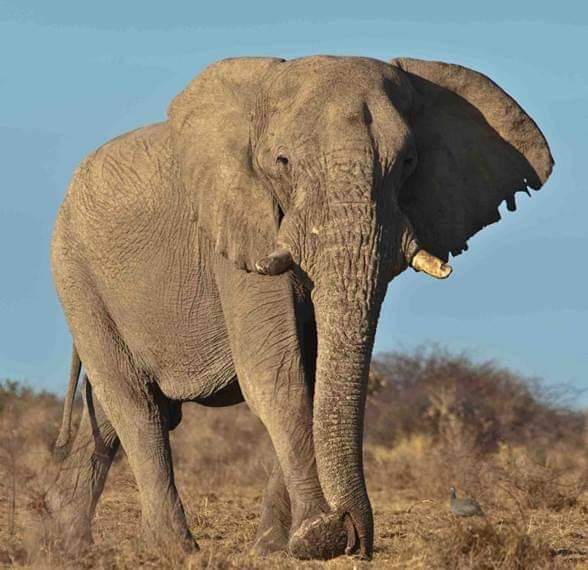
The silent walk of an elephant always amazes us. Here is the huge , bulky beast carefully tiptoeing around or between objects. ‘Tiptoe’ is not just a descriptive word — they actually walk on their toes, but their soles spread out to support their weight and they have built-in fibrous shock absorbers to cushion the impact as they touch the ground.
The Ana tree and the elephants — one great team.
Most of the savanna elephants found in Zimbabwe are found at the Mana pools. The Mana pools are found close to the mighty Zambezi river, and although it is a hot and dry area, there is plenty water via the river, but… There is a problem… Many Nile crocodiles litter the banks and water.
In the dry season, many animals suffer greatly and need food and water and this is when those great big, helping giants step in…
Unlike the other thirsty animals, it is not the river that attracts the elephants, but the Ana trees — with their large, circular seed pods. The tree has a long taproot and it reaches down 20-40 metres- so it is resistant to droughts, which destroys most trees (its roots reach underground water).
This tree is different to other trees in a wonderful way; a way greatly benefitting wildlife — but only with the help of the elephants. Nature can be brutally tough, but in the end, it has fantastic, almost magical, set up. This proves it.
Most trees usually get their leaves in the rainy season and lose them in the dry season. This incredible tree is different, as the Ana tree loses them in the rainy season and sprouts more life (leaves) in the dry season. However, it does not only bear leaves, but also dangling yellow flowers. The leaves come first and then the flowers and those pretty flowers attract the pollinating insects, which in turn, attract the birds that feast on them.
This is also a critical time for the other herbivores, the lower fruit (fat seed pods) has already been eaten, and the starving and thirsty animals cannot reach the ones growing higher up. The elephant’s arrive to save the day and stand on their hind legs to reach up to pick off the higher pods/fruit — scattering seeds and pods all over the place — much to the delight of the herbivores. Besides being nutritious food, they also hold much needed moisture.
The Ana tree, with the help of the elephants, save many lives.
There are only 3 species of elephant in the world —
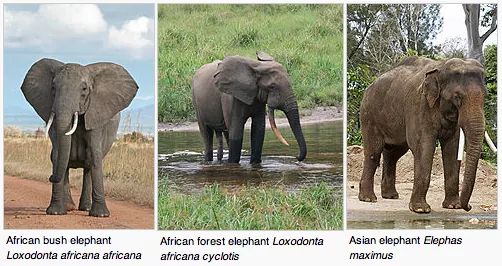
- The African/ bush/ savanna elephant.
- The African forest elephant.
- The Asian or Indian elephant.
Africa is home to two species — The African forest elephant is a different SPECIES, and not a subspecies of the Savanna/bush elephant.
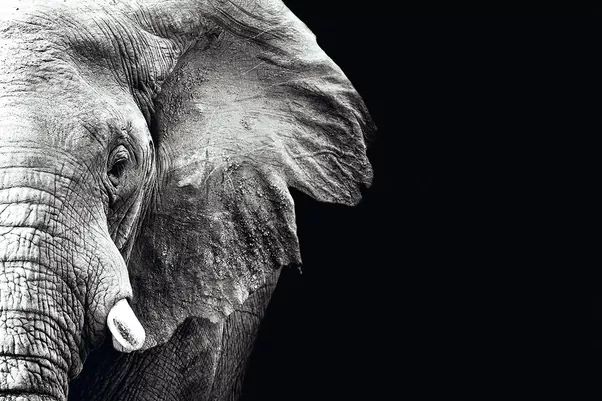
A bit more about the elephant’s built in air-conditioning system — their ears. As the day grows hotter their body temperature rises and they flap their ears to send air down their body, cooling them and the blood vessels in their ears and these blood vessels cool their blood. On windy days you may see elephants standing with their backs to the wind with their ears spread out — and they do this so that their ears catch the breeze and cools those blood vessels and this way, they save energy (if its windy they are not charging you — just cooling off).
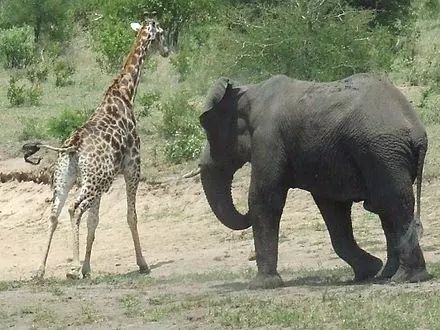
Elephants have a scent/smell. A pleasant one. They have a musty, earthy smell. A bull in musth has a stronger scent, and some find it a bit too powerful and one that verges on the unpleasant side. This is due to a sudden increase in the male hormone — testosterone, and also adding to that fact, is that he often dribbles urine. Luckily, that ‘musth’ vanishes after a while and he is back to the usual, pleasant elephant scent.
* During this time, the poor bull has no control of his emotions and goes ‘crazy’ for a short while, like this bull elephant chasing a giraffe, that quickly escaped.
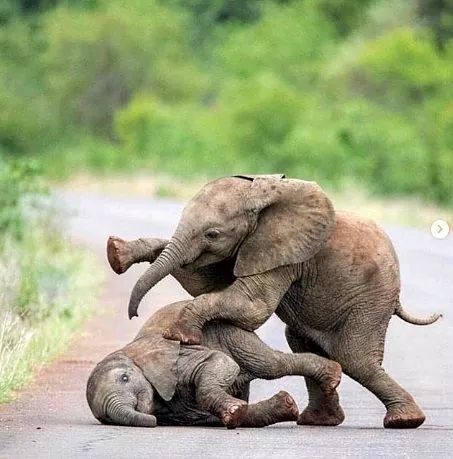
Elephant calves are incredibly playful and this is where they learn very important social and physical skills. However, this ‘playfulness’ is also active in adult elephants, and even teasing and lighthearted behaviour was observed in 40 year old– upwards male and female mature elephants.
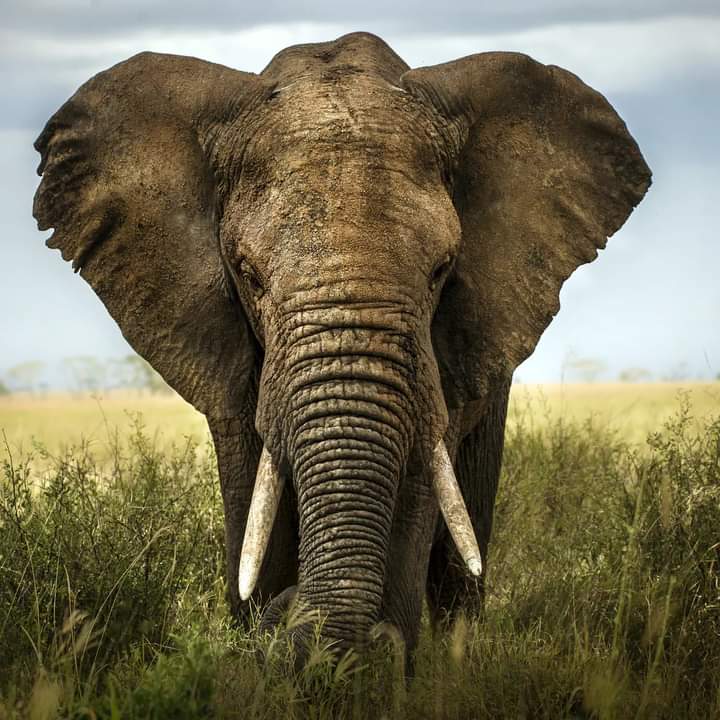
African Elephants share a powerful disorder that sometimes we also suffer from — Post Traumatic Stress Disorder (PTSD). Poached elephants and herds that were exposed to, but survived trauma (like poaching and hunting), likely suffer from PTSD.
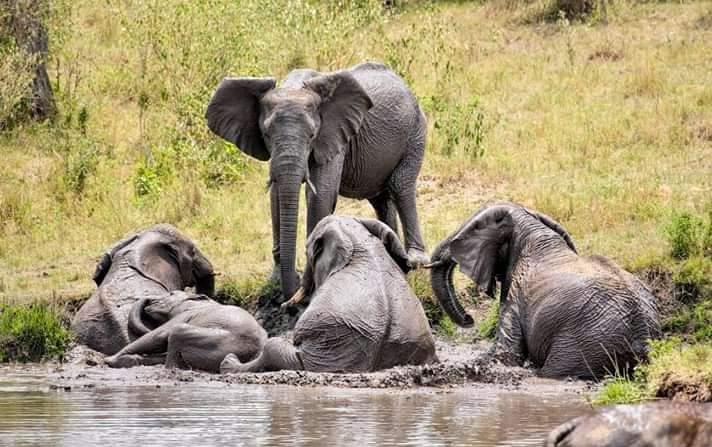
African Elephants can get sunburns, this is the reason as to why they are always covering themselves in mud .
An elephant’s brain can weigh up to 5kg this is the reason as to why they have a fabulous memory . The brain is larger than any other land animal.
The African Elephant’s Ivory Tusk
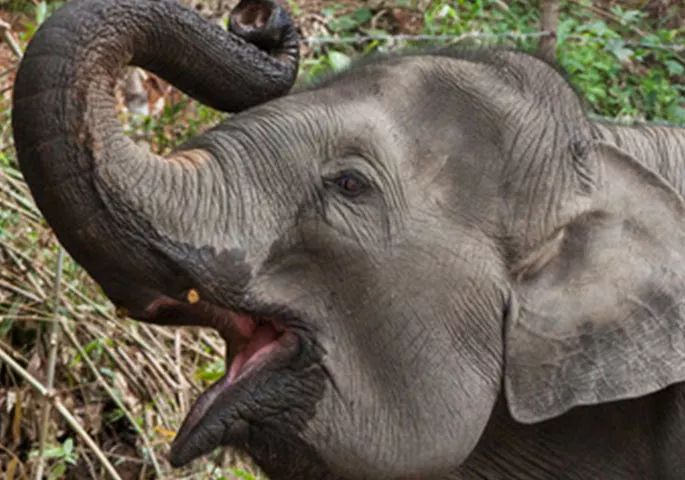
The ivory tusk is a unique symbol that gives elephants the majestic appearance among other animals in the wild. Both male and female African elephants have tusks. For the Asian elephants, only some males and females. About 50% of female elephants in Asia don’t have tusks — due to genetic factors. These ‘tusks’ are called ‘tushes’, and most are only 1-3 inches long and only visible when the mouth is opened.
The average length of the tusk of an African elephant is about 5-6 feet (1.5-2 metres) and weighs about 50 pounds (23kg). Tusks grow in layers. In most animals, the canines are the tusk-like teeth, but in elephants, they are not canines and are actually elongated incisors. About one third of it is not always visible and tucked in the head as pulp cavity –tissue, blood and nerves. The outer ivory is composed of dentine and enamel.
They are used as weapons against predators or to battle against other elephants. They are also used for digging, stripping bark, protecting the trunk and moving trees. Also, the females are attracted by the majestic tusks of the males before mating. Evidence has pointed that elephants prefer one tusk from the other, like being left or right handed in humans. The preferred one is called the ‘master tusk’.
Sadly, elephants have been heavily hunted for the sole reason of their tusks.
- Convention on International Trade of Endangered Species (CITES) has been making efforts to save elephants.
We told you about three species of elephants found in the world — two in Africa and one in Asia. The Asian elephant is scientifically called Elephas maximus. It is the largest living land animal in Asia.
The Asian elephant is smaller in whole size than the African elephant. It also has smaller round ears and one prehensile “finger” at the tip of its trunk instead of two in the African elephant. The Asian species has four (4) toes on its hind foot unlike three (3) in the African species. Also of interest is the ribs, which are 19 pairs in the Asian elephant and 21 pairs in the other.
Unlike the African elephant, the Asian elephant is more agile at using their feet together with their trunk for manipulating objects.
- They are endangered species
A sobering thought…
The rapid rate of poaching is more serious than what we thought. For example, in one — only one decade (10 years — decade), 110, 000 African elephants were killed. In 1930 there were 10 million elephants across Africa. Not one or two (that is still plenty), but 10 million!
An indepth census was carried out in 2016, and revealed Africa only has 352,271 savanna/bush elephants left. In total Africa has just 415, 000 (that includes the African forest elephant)!
Sad to say, at this rate the African elephant will be extinct in the wild in as little as 20-30 years!
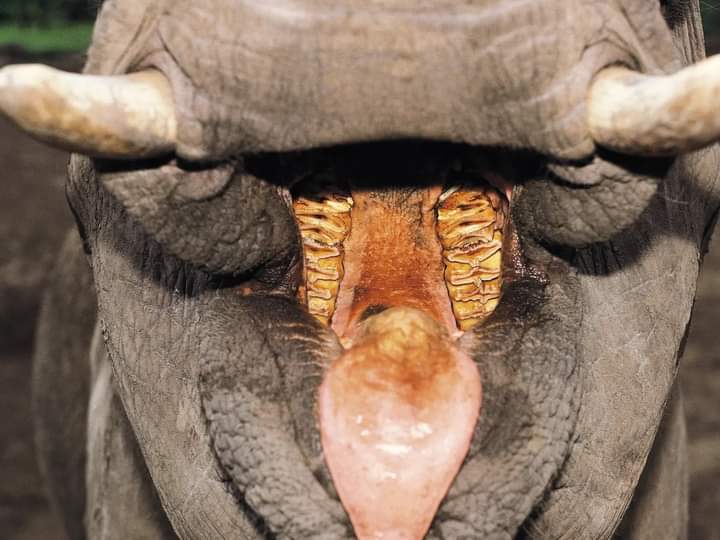
When an animal shows tusks, usually they are long canines, but an African elephant’s tusks, are long incisors.
Here are some facts about the anatomy of an African Elephant:
Heart and liver: The elephant heart weights 22 kilograms and circulates about 450 litres of blood. Inner ‘cleaning’ is performed by a 77 kilograms liver.
Water and trunk: To drink its 9 litres of water at a time, the elephant uses its trunk which weighs 113 kilograms.
Tongue: Helping the swallowing process is a 12 kilogram elephant tongue.
Food and intestines: The approximately 250 kilograms food eaten every day passes through 18 metres of intestines. Eventually processed into about 100 kilograms of elephant dung per day. African elephants are herbivorous. Their diet varies according to their habitat. Elephants living in forests, partial deserts and grasslands all eat different proportions of herbs and tree or shrubbery leaves. Elephants inhabiting the shores of Lake Kariba have been recorded eating underwater plant life.
Digestion: Elephants only digest about 40% of what they eat and therefore, they need to spend two-thirds of every day eating.
Gas: An elephant ‘releases’ 2000 litres of methane gas per day.
Skin: An elephants skin weighs 450 – 750 kilograms.
Tail: An elephants tail weighs 11 kilograms.
Fighting: The longest recorded fight between two elephants was recorded at 10 hours and 56 minutes.
Matriarch: Elephant herds consist of females and the young. A herd is led by a matriarch (grandmother). As young males reached maturity they are chased away by the herd. Bull elephants join the herd only for mating.
Gestation: An elephants gestation (conception to birth) is 23 months. Gestation period tends to be slightly longer than in the Asian elephant.
Sound: Most of the communication between elephants occurs at an infra sound level.
Call: It is estimated that an area of 50 square kilometres is filled with particular elephant ‘call’ in infra sound. This might increase to about 300 square kilometres at dusk due to lower temperatures.
Eyes: An elephants eyes are very small in relation to its head. The eye contains very few photoreceptors and they cannot see very well further than a few hundred feet.
Speed: An elephant can walk rather fast and charge even faster.
No jumping: Elephants cannot jump.
Swimming: Elephants love water and are excellent swimmers.
Trunk: An African elephants trunk is the most versatile of all mammalian creations being used as a nose, arm, hand and multipurpose tool. It is powerful enough to kill a lion with a single swipe, yet the finger-like lobes at the end are adept enough to pluck a feather from the ground.
Trunk muscles: The trunk is boneless and is composed of an estimated 40 000 muscles.
Tusks: African Elephants tusks are elongated upper incisor teeth, which grow continuously throughout the elephants life. They are not always an exact match, as this depends on which side they favour much like left and right-handed humans.
Ears: African elephants ears are covered in veins, which form distinct and unique patterns which can be used to identify individuals – much like human fingerprints. An elephants ears are packed with blood vessels and when flapped, they quickly lower the animals body temperature. This swiftly circulating blood is cooled by about 9 degrees Fahrenheit while in the elephants ear.
The African Bush Elephant is an intelligent animal. Experiments with reasoning and learning show that they are the smartest ungulates together with their Asian cousins. This is mostly due to their large brain.

